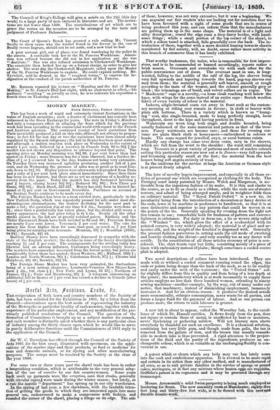That worthy tradesman, the tailor, who is responsible: for first
impres- sions, and is to be commended or banned accordingly, reports rather a brisk season. Overcoats and overeloaks vie with each other for the public convenience out of doors. The overcoat most in use, is long- waisted, falling to the middle of the calf of the leg, the sleeves being very full upwards and tapering towards the hand, peg-top sleeves one may term them ; the material is generally soft beaver, smooth or rough according to the taste of the wearer, and the colours generally grey or black ; the trimmings are of braid, and velvet collars are in vogue. The " Mackenzie " cape is a novelty,—a loose cloak reaching well below the knee, with wings for the arms instead of an entire cape : Scotch woollen fabric of every variety of coleur is the material. Indoors, single-breasted coats cut away in front such as the custom- ary morning or riding coat remain in favour; in cloth or beaver with plain silk buttons. There is a variety which is known as " loung- ing " coat, also single-breasted, made to hang perfectly straight, loose throughout, short to the hips and having pockets in front. Waistcoats are worn long both single and double breasted, being usually fashioned of the same material and pattern as that of the trou- sers. Fancy waistcoats are become rare ; and those for evening cos- tume are plain black cloth or kerseymere—embroidered in colours or beads. The same regard for jewelled, onyx, or coral buttons exists.
Hardly any change has come over dress coats, save in the sleeves, which are full from the wrist to the shoulder : the waist still remaining long. Trousers in a great variety of patterns and most of sombre colours suiting this particular season are now cut a la Zoom—very full upwards and becoming specially small at the foot ; the material from the best houses being soft angola entirely of wool.
In the uniforms for the service at large the Austria er German style is at present firmly adopted.


























 Previous page
Previous page